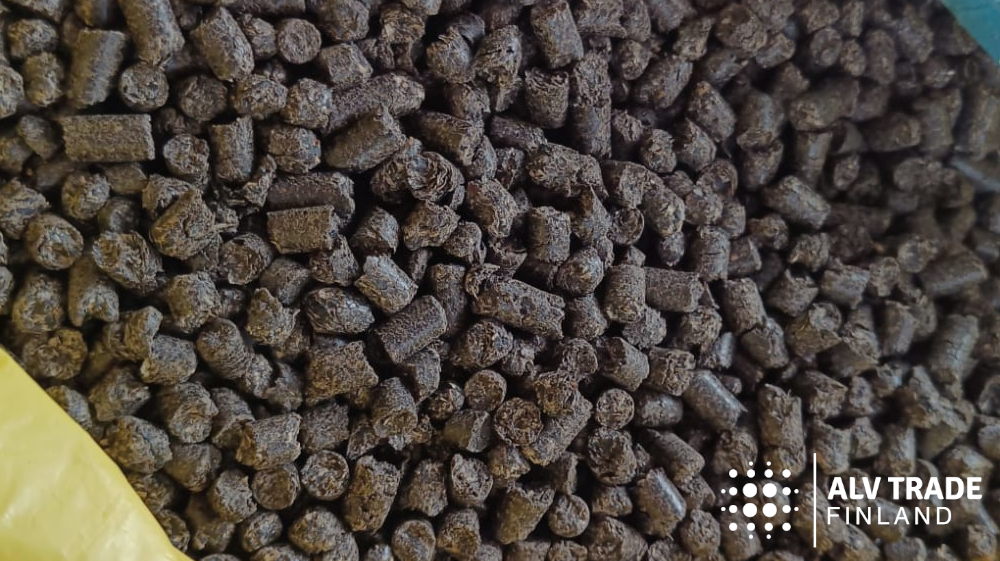
Woodchips

Sunflower pellets are an economical, ecological and efficient alternative compared to wood pellets, because forests are cut down to make wood pellets.
The use of sunflower pellets is inexpensive, especially in countries with a large production of sunflower oil. Sunflower and wood pellets have almost the same calorific value, so sunflower pellets are very competitive among biofuels. Fuel pellets made from sunflower seed shells have been used in power plants for a long time due to their remarkably high calorific value.
Sunflower pellets are used a lot in biomass power plants and industrial boilers. Sunflower pellets usually come from sunflower oil production plants.
The husks of the seeds are pressed with great force at high temperature to form a pellet. Some of the shells are already used at the oil production plant to cover the plant's own energy needs.
Depending on the size of the plant's energy needs and the amount of production, some of the by-products of oil production may be left over after the plant's energy needs. In this situation, the shells have to be transported elsewhere, either for energy production, as bedding or as low-quality fodder for livestock.
The sunflower pellet works like a regular wood pellet and is a 100% natural product. Ash is very suitable for use as fertilizer.

Sunflower seeds, like other biological substances, consist of cellulose, hemicellulose and lignin. Sunflower seed shells contain 48.4% cellulose, 34.6% hemicellulose and 17% lignin. Lignin is a binder that increases the mechanical strength of the material. Lignin binds the fibers of the biomaterial together. In addition, lignin contains a lot of carbon and wheat, which are substances that produce a lot of heat. A large amount of ash may require special ash removal systems from the combustion process, so that the process can operate continuously without regular breaks for ash removal.
The ash of organic fuels can be used as fertilizer, because their ash contains all the most important plant nutrients.
Ash contains the plant nutrients phosphorus and potassium and the micronutrients zinc, copper, manganese, cobalt and iron. Sunflower pellets can also be burned with coal. In this case, part of the used coal can be replaced with pellets, and the harmful environmental emissions of the combustion process are reduced.
One ton of sunflower pellets contains approx. 5300kWh of energy, one throwing cube of dry birch wood contains approx. 1000kWh.
The pallet contains approximately the same amount of energy as 5.2 throwing cubes of birch bark.


Raaka-aine: auringonkukansiemenen kuori
100% luonnollinen tuote
Tuotetiedot:
- Moisture content 8,5 m-%, menetelmä SFS-EN ISO 18134-2:2017
- Kalorimetrinen lämpöarvo 20,96 MJ/kg, d, menetelmä SFS-EN ISO 18125:2017
- Tehollinen lämpöarvo 19,54 MJ/kg, d, menetelmä SFS-EN ISO 18125:2017
- Tehollinen lämpöarvo 5,43 MWh/t, d, menetelmä SFS-EN ISO 16933:2016
- Tehollinen lämpöarvo saapumistilassa 17,68 MJ/kg, menetelmä SFS-EN ISO 18125:2017
- Tehollinen lämpöarvo saapumistilassa 4,91 MWh/t, menetelmä SFS-EN ISO 16933:2016
- Tuhkapitoisuus: 3,3 m-%, d, menetelmä SFS-EN ISO 18122:20158, 550º
- Pellettin pituus on 10-30mm
- pellettin halkaisija 6-8 mm
- Rikkipitoisuus 0,02
- Paino 600 kg/m³
Alkuaineanalyysi: hiili 47,7%, vety 5,8%, typpi 1,4%, happi 41,4%, rikki 0,05, tuhka 4%
Eräkoko: suursäkki 900 kg, 1100 kg, irtotavaratoimitus puhallusautolla. Toimitukset alkaen 20-24 000kg, joka on täysikuorma. Asiakas vastaa kuorman purkamisesta (suursäkit).
Laatukriteeristö SFS-EN ISO 17225-6:2021 kiinteät polttoaineet
Alkuperämaa: Kazakstan, Ukraina, Bulgaria
We recommend home users to stock a year's worth of pellets in advance.
